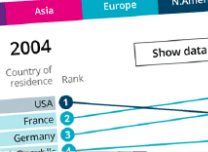Economy The second estimate of gross domestic product (GDP) shows that the UK economy grew by 0.4% in Quarter 3 (July to Sept) 2017, unrevised from the preliminary estimate of GDP.
Growth in private consumption increased by 0.6% in Quarter 3, picking up from the relatively subdued growth of 0.2% in the previous quarter.
Services output is estimated to have increased by 0.4% in Quarter 3.
Growth in consumer prices including owner occupiers' housing costs (CPIH) remained at 2.8% for October 2017, with the main contributions being transport, and food and non-alcoholic beverages.
The UK unemployment rate remained at 4.3% in the three months to September 2017, its joint lowest since 1975; however, the employment rate decreased by 0.1 percentage points on the previous quarter, as the number of people in work decreased for the first time since August to October 2016.
UK gross domestic product (GDP) in volume terms was estimated to have increased by 0.4% between Quarter 2 (Apr to June) and Quarter 3 (July to Sept) 2017, unrevised from the preliminary estimate of GDP.
Services remained the strongest contributor to GDP growth in Quarter 3 2017, with the components of the output approach broadly unrevised from the preliminary estimate.
The rate of growth in household final consumption expenditure strengthened to 0.6% between Quarter 2 and Quarter 3 2017, with car purchases recovering somewhat from a low Quarter 2.
Business investment growth softened to 0.2% between Quarter 2 and Quarter 3 2017.
GDP per head was estimated to have increased by 0.3% between Quarter 2 and Quarter 3 2017. Services output increased by 0.4% in Quarter 3 (July to Sept) 2017 compared with Quarter 2 (Apr to June) 2017; following growth of 0.4% between Quarter 1 (Jan to Mar) 2017 and Quarter 2 2017.
The business services and finance sector made the largest contribution to the quarterly growth, contributing 0.25 percentage points.
In the three months to September 2017, services output increased by 1.4% compared with the three months ending September 2016; this growth is at its lowest since the three months ending October 2013.
The Index of Services increased by 0.1% between August and September 2017.
Motion pictures made the largest contribution at industry level to the month-on-month increase, contributing 0.06 percentage points.
Gross fixed capital formation (GFCF), in volume terms, was estimated to have increased by 0.2% to £81.4 billion in Quarter 3 (July to Sept) 2017 from £81.2 billion in Quarter 2 (Apr to June) 2017.
Business investment was estimated to have increased by 0.2% to £45.8 billion in Quarter 3 2017 from £45.7 billion in Quarter 2 2017.
Between Quarter 3 2016 and Quarter 3 2017, GFCF was estimated to have increased by 1.8%, from £80.0 billion and business investment was estimated to have increased by 1.3%.
The assets that contributed to GFCF growth between Quarter 2 2017 and Quarter 3 2017 were intellectual property products and dwellings.
The sectors contributing to GFCF growth over the same period were business investment, public corporations dwellings and private sector dwellings. Employment and labour market There were 790,000 young people (aged 16 to 24) in the UK who were not in education, employment or training (NEET); this number was unchanged from April to June 2017 and down 65,000 when compared with July to September 2016.
The percentage of all young people in the UK who were NEET was 11.1%; the proportion was unchanged from April to June 2017 and down 0.8 percentage points from July to September 2016.
37.9% of all young people in the UK who were NEET were looking for work and available for work and therefore classified as unemployed; the remainder were either not looking for work and/or not available for work and therefore classified as economically inactive. People, population and community An estimated 1.9 million adults aged 16 to 59 years experienced domestic abuse in the last year, according to the year ending March 2017 Crime Survey for England and Wales (1.2 million women, 713,000 men).
The police recorded 1.1 million domestic abuse-related incidents and crimes in the year ending March 2017 and of these, 43% were recorded as domestic abuse-related crimes; domestic abuse-related crimes recorded by the police accounted for 32% of violent crimes.
There were 46 arrests per 100 domestic abuse-related crimes recorded by 39 police forces in the year ending June 2017.
The majority of victims of domestic homicides recorded between April 2013 and March 2016 were females (70%).
A decision to charge was made for 72% of domestic abuse-related cases referred to the Crown Prosecution Service (CPS) by the police, and of those that proceeded to court, convictions were secured for 76% of domestic abuse-related prosecutions.
There were 305 refuge services operating in England and Wales in 2017.
A total of 83,136 high-risk cases were discussed at multi-agency risk assessment conferences in the year ending March 2017, equating to 36 cases per 10,000 adult females. | 










No comments:
Post a Comment